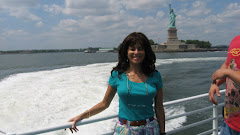
5 Tips On How to Feel Comfortable, Confident and Carefree Your First Time Overseas By Karla Scott, MBA
Are you intimidated by the notion of traveling overseas on business?
Do you dream of taking a crash course on how to be effective in your new destination?
Are you worried you may make mistakes in this unfamiliar culture?
Relax! You are not alone! Here are steps you can take that can help make you feel competent and confident in your first overseas venture.
1. Do your homeworkIf you choose to do business in another culture, you must accept its protocol, norms, and ways of doing business. Be insatiably curious. Go to your local bookstore and use the internet to research the other culture’s history, geography, key symbols, tourist attractions, national dishes, popular sports, non verbal communication rules, leaders and celebrity culture. Study the local map including the mass transit or metro map and the area surrounding your hotel. You will feel more comfortable exploring and communicating when you have gone the extra mile to learn something about your new culture. The best part is that by taking an interest in the other culture, your actions will convey genuine respect. Your efforts will be appreciated by most (if not all) whom you meet. It will set you apart from many Americans who don’t bother to learn something about the other culture. Remember, people all over the world know U.S. popular culture, government, history and many even speak English. Isn’t it reasonable for us to make the effort to meet them at least half way?
For a crash course in local customs and etiquette, I recommend the easy-to-read Culture Shock series. They are compact guides (250 pages) that provide a comprehensive and accurate portrayal of culture in more than 35 countries, with practical tips on how to be effective there. They are well-researched, authentic, and entertaining. You can order Culture Shock online from all leading book sellers.
2. Learn a few commonly used words and phrasesRest assured you do not need to enroll in a 3-month immersion class. Most of the world accommodates English speaking guests. In fact, it is the second most spoken language, behind Mandarin, in the world. Your experience can be greatly enhanced by showing basic respect. You can accomplish this by learning some common courtesy expressions such as hello; goodbye; thank you; and please and one of my favorites: “Where are the toilets?” “How much is that ________?” also comes in very handy when bargaining.
You will be amazed by how instantly connected you feel when upon arrival, someone says hello in their language and you can respond in the same language or when they say thank you, you can reply appropriately.
I strongly urge you to refrain from bursting into a conversation leading with English words. Instead (or what is more respectful is to) always first ask “Do you speak English?”
You can listen to a basic language tape daily before you go that provides language basics including numbers, useful questions, shopping terms, hotel/taxi/ and airport expressions, and dining phrases.
3. Prepare for time zone change realities and make travel as easy as possibleGo a day early, if possible, to help your body and mind adjust to time zone differences. Going a day early can also help you to get your bearing on the new destination. Your first day there, don’t go to sleep until 10PM no matter what. That way, you can wake up with the locals and it will help you function effectively, more quickly. While you sleep, always turn the clock around so you won’t see the time that could distract your sleep pattern. It’s best not to know the time while you are attempting to sleep.
Here are a few helpful hints:
□ Sleep on the flight if at all possible.
□ Wear eye shades to notify flight attendants you prefer not to be bothered.
□ Wear a noise reduction headset to tune out noises and engine roars.
□ During the flight, eat light, drink lots of water to stay hydrated, and minimize alcohol consumption.
□ Bring a bean-filled travel pillow (they really do help!).
□ For longer flights (8 hours+), prepare to walk around periodically in order to allow your blood to circulate properly. It is not uncommon for people over 50 to suffer from fatal blood clots during long overseas trips, because the victims failed around during the flight.
□ Pack a couple of bagels or oatmeal bars in your carry on in order to fill in “food gaps”.
□ Pack a toiletry kit so you may freshen up on board prior to landing.
□ Pack one wash cloth for each hotel (wash cloths are not common everywhere).
If possible, strive to negotiate to sit in the business class section where it is quieter. The seats are roomier and they recline substantially. However, if you must fly coach, book early enough to select a comfortable window or aisle seat. You do not want to be trapped in a middle seat in coach for 8-15 hours! Be sure your carry-on bags are wheeled because you will walk long distances inside international airports. Also, they are often long flight delays in some parts of the world. Don't carry on anything you are now willing to cart around for unlimited periods of time.
Finally, wear a round-the-neck pouch that contains your passport, travel itinerary, ID, business credit card, small bills (US and other currency) and a pen. This way you won’t need to go digging thru bags at numerous security checkpoints. Once, I observed a woman miss her connecting flight because she could not produce her travel documents in a timely manner. You will be forever grateful if you wear one of these pouches on a lanyard available at most luggage stores for $20 or less.
4. Upon arrival, sink into the rhythm and flavor of the cultureAfter you check in, you can choose to either explore the area around your hotel, or to take a taxi to a busy section of town. Here are suggestions on what to do there:
Sit at a café at a busy intersection and people watch to see the written and unwritten rules (you have already read about), in action.
Go to a market or grocery store—you can learn a lot about people by watching how they connect with their food.
Visit a park; sit and watch the show.
Dine where locals dine; match their behavior.
If you are daring, take public transportation. Be sure you’ve studied the maps in advance and have exact change or a ticket before you board. Find out from your hotel’s concierge the best mode of returning to your hotel. [Beware of trying this in countries where signage is in a script different from Roman such as Chinese/Japanese characters, Arabic, Persian, Ethiopian, Russian (Cyrillic), India (Brahmi), or Greek.] I have taken public transportation alone in many parts of the world because I learn to recognize the destination words. In Tokyo, I was thankful to be accompanied by a Japanese person during my subway ride: I don’t read Japanese characters! I would probably still be trapped in the Tokyo subway system had I ventured to do this on my own.
Watch popular television shows in your hotel room while you are getting dressed. This gives you a feel for local values, humor, aesthetics, nonverbal communication rules, and popular marketing campaigns.
Memorize exchange rate(s). Know basic currency conversions in denominations of 1, 5, 20, 50 etc. For example, prepare to recognize what 20 Euros or 2500 Yen means on the menu.
Avoid renting a car when traveling abroad alone. The rules of the road are significantly different, and you probably will not be able to read road signs. By American standards, traffic overseas is at best, chaotic.
Always carry a few essential tools while traveling around:
□ something with the name of your hotel written in local script (take hotel pen, matches, or pad) to show taxi driver how to return you to your hotel.
□ a roll of toilet paper—just in case! Often, you will not find toilet paper (especially the soft version we know and love)
□ camera
□ guidebook containing useful words and phrases
□ notepad for journaling
5. Let your host play host--don’t rush into business. If you are being hosted, let your hosts set the tone and pace. Allow them to welcome you and guide you around. If possible, accept all invitations. Show appreciation and respect for their culture by allowing them to take pride in showing you their world. Keep an open mind. Leave judgmental thinking at home and practice the platinum rule: Do unto others as they would have you do unto them.
Make the unfamiliar familiar by learning about the culture in advance of your trip.
The best part is that by taking an interest in the other culture, your actions will convey genuine respect. Your efforts will be appreciated by most (if not all) whom you meet. It will set you apart from many Americans who don’t bother to learn something about the other culture. Remember, people all over the world know U.S. popular culture, government, history and many even speak English. Isn’t it reasonable for us to make the effort to meet them at least half way?
Helpful ResourcesFor a crash course in local customs and etiquette, I recommend the easy-to-read Culture Shock series. They are compact guides (250 pages) that provide a comprehensive and accurate portrayal of culture in more than 35 countries, with practical tips on how to be effective there. They are well-researched, authentic, and entertaining. You can order Culture Shock online from all leading book sellers.
Other helpful sources are: CIA World Factbook Sheets. The US government provides profiles of countries and territories around the world. Information on geography, people, government, transportation, economy, communications, and more. https://www.cia.gov/library/publications/the-world-factbook/
Culture Grams Cultural reports for more than 200 countries each include 25 categories such as land and climate, history, personal appearance, greetings, gestures, family, diet, arts, holidays, economy, education, religion, health, a country map, and events and trends.
Each individual Culture Gram four-page report (there are 201) is available individually for download for $4 per report.
http://www.culturegrams.com/products/individual.htm
Consular Information Sheet The US State Department’s Office of American Citizens Services and Crisis Management (ACS) administers the Consular Information Program, which informs the public of conditions abroad that may affect their safety and security. Country Specific Information, Travel Alerts, and Travel Warnings are vital parts of this program. http://travel.state.gov/travel/cis_pa_tw/cis/cis_1765.html#F
Executive Planet™ provides valuable tips on business etiquette, customs and protocol for doing business in more than 50 countries. http://www.executiveplanet.com/index.php?title=Main_Page
Lonely Planet Destination Guides. http://www.lonelyplanet.com/



































.jpg)
.jpg)



